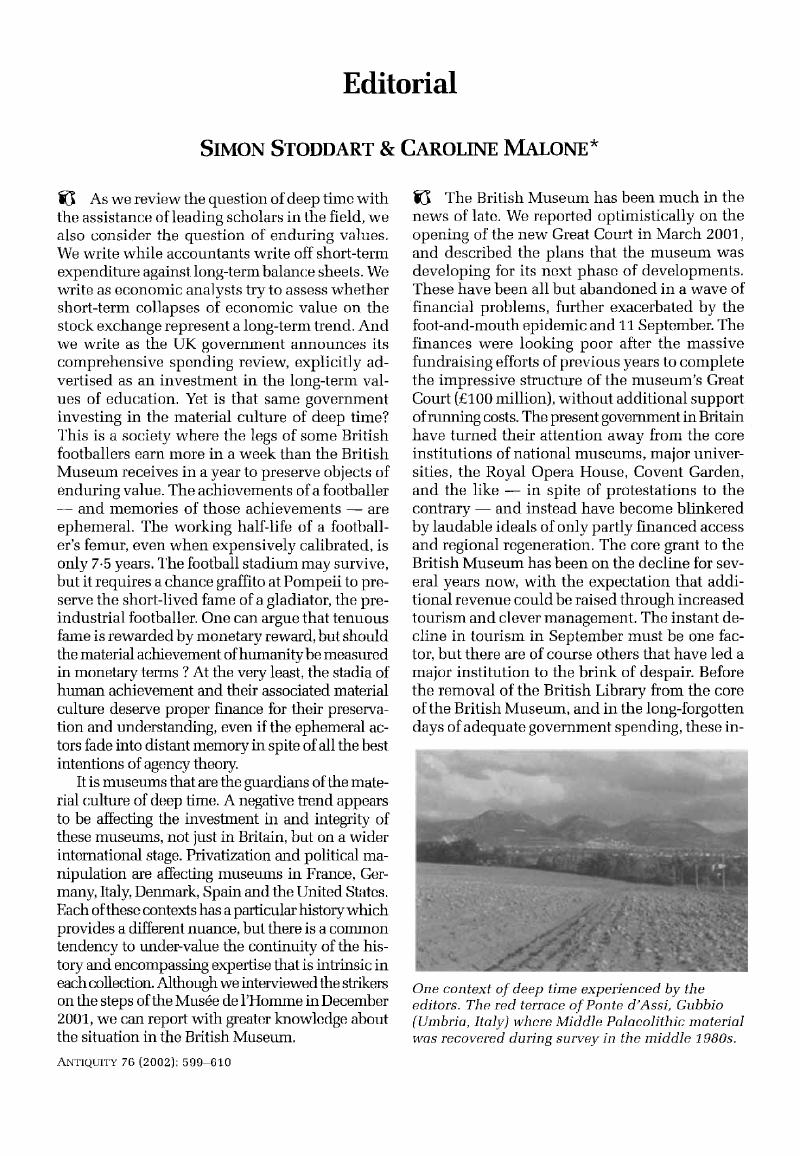No CrossRef data available.
Article contents
Editorial
Published online by Cambridge University Press: 02 January 2015
Abstract
An abstract is not available for this content so a preview has been provided. As you have access to this content, a full PDF is available via the ‘Save PDF’ action button.

- Type
- Editorial
- Information
- Copyright
- Copyright © Antiquity Publications Ltd. 2002
References
References
Bluford, L.K.
1981. Bones: ancient men and modern myths.
New York (NY): Academic Press.Google Scholar
Blumenschine, R.J.
1991. Hominid camivory and foraging strategies, and the socio-economic function of early archaeological sites, Philosophical Transactions of the Royal Society of London B
334: 211–21.Google ScholarPubMed
De Waal, F.B.M. (ed.). 2001. Tree of origin: what primate behaviour can tell us about human social evolution. Cambridge (MA): Harvard University Press.Google Scholar
Gamble, C.
1999. The Palaeolithic societies of Europe. Cambridge: Cambridge University Press.Google Scholar
Goldberg, P., Weiner, S., Bar-YOSEF, O., Xu, Q. & Liu, J.
2001. Site formation processes at Zhoukoudian, China, Journal of Human Evolution
41(5): 483–530.Google Scholar
Hawkes, K., O’Connell, J.F. & Blukton-Jones, N.B.
2001. Hunting and nuclear families: Some lessons from the Hadza about men’s work. Current Anthropology
42(5): 681–709.Google Scholar
Isaac, G.L.
1984. The archaeology of human origins: studies of the Lower Pleistocene in East Africa 1971–1981, in Wendorf, F. & Close, A. (ed.), Advances in world archaeology: 1–87. New York (NY): Academic Press.Google Scholar
O’Connell, J.F., Hawkes, K. & Blurton-Jones, N.G.
1999. Grandmothering and the evolution of Homo erectus, Journal of Human Evolution
36(5): 461–85.Google Scholar
Sollas, W.J.
1915. Ancient hunters and their modern representatives. London: Macmillan.Google Scholar
Tooby, J. & De Vore, I.
1987. The reconstruction of hominid behavioral evolution through strategic modeling. in Kinzey, W.C. (ed.). The evolution of human behavior: primate models: 193–237. Albany (NY): State University of New-York Press.Google Scholar
Washburn, S.L. & De Vore, I.
1961. Social behavior of baboons and early man, in Washburn, S.L. (ed.), Social life of early man: 91–105. Chicago (IL): Aldine.Google Scholar
Weiner, S., Xu, Q., Goldberg, P., Liu, J. & Bar-Yosef, O.
1998. Evidence for use of fire at Zhoukoudian, China, Science
281: 231–3.Google Scholar
Wrangham, R.W., Jones, J. Holland, Laden, G., Pilbeam, D. & Conklin-Brittain, N.L.. 1999. The raw and the stolen: cooking and the ecology of human origins, Current Anthropology
40(4): 567–94.Google Scholar
References
Adcock, G.J., Dennis, E.S., Eastkal, S., Huttley, G.A., Jermiin, L.S., Peacock, W.J. & Thorne, A.
2001. Mitochondrial DNA sequences in ancient Australians: implications for modern human origins, Proceedings of the National Academy of Science USA
98(2): 537–42.Google Scholar
Asfaw, B.
et al
2002. Remains of Homo erectus from Bouri, Middle Awash, Ethiopia, Nature
416: 317–20.Google Scholar
Brunet, M.
et al.
2002. A new hominid from the Upper Miocene of Chad, Central Africa, Nature
418: 145–51.Google Scholar
Cann, R.
2002. Human evolution: tangled genetic routes, Nature
416: 32–3.CrossRefGoogle ScholarPubMed
Collcutt, S.
2001. The Sackung hypothesis: a challenge for Palaeolithic prospection, in Milliken, S. & Cook, J. (ed.), A very remute period indeed. Papers on the Palaeolithic presented to Derek Roe: 223–33. Oxford: Oxbow.Google Scholar
Jochim, M.
1976. Hunter-gatherer subsistence and settlement: a predictive model. New York (NY): Academic Press.Google Scholar
Jochim, M.
1998. Hunter-gatherer landscape: southwest Germany in the late Palaeolithic and Mesolithic. New York (NY): Plenum Press.Google Scholar
Vekua, A.
el al.
2002. A new skull of early Horaofrom Dmanisi, Georgia, Science
297: 85–9.Google Scholar


